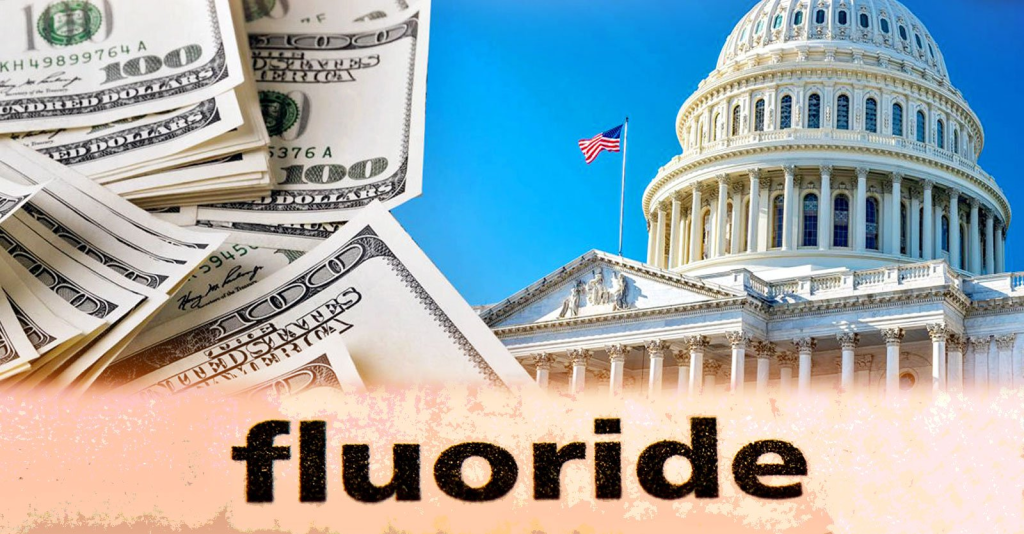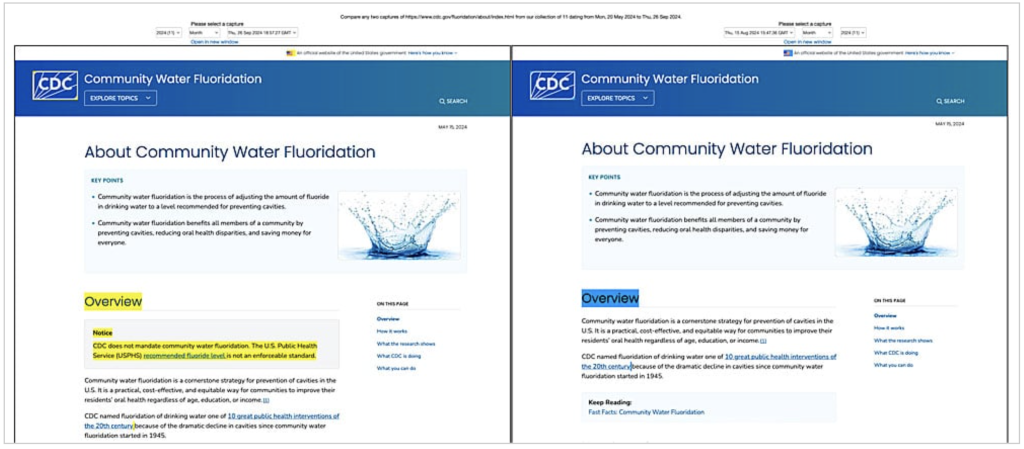
Please Follow us on Gab, Minds, Telegram, Rumble, Gettr, Truth Social, Twitter
The Association of American Pediatricians (AAP), the American Dental Association (ADA) and other pro-fluoridation groups rushed to confirm their staunch support for community water fluoridation after a California federal judge last month ruled that fluoridation at current U.S. levels poses an “unreasonable risk” of reduced IQ in children.
U.S. District Judge Edward Chen also ruled that the U.S. Environmental Protection Agency (EPA) needs to enact a regulation that will eliminate the risk.
The EPA’s only official response so far to last month’s ruling is that the agency is reviewing the decision. The Centers for Disease Control and Prevention (CDC), which has long promoted water fluoridation, has not issued any statement.
The ADA said it “remains staunchly in support of community water fluoridation at optimal levels to help prevent tooth decay.” It said the court ruling, “provides no scientific basis for the ADA to change its endorsement of community water fluoridation as safe and beneficial to oral health.”
However, Chen’s 80-page ruling summarizes and evaluates the extensive scientific data. The data include a key report researched and compiled over six years by the U.S. Department of Health and Human Services’ National Toxicology Program (NTP), along with gold-standard epidemiological studies from the U.S., Mexico, Canada and Europe by top hazardous substances researchers.
Although the ruling did not specify the exact level at which fluoridation causes brain damage, the levels in U.S. water present an unreasonable risk, Chen found.
The decision didn’t sway the AAP. “There is nothing about the current decision that changes my confidence in the safety of optimally fluoridated water in the U.S.,” said Dr. Charlotte W. Lewis, a member of the AAP Section on Oral Health.
“Oral health should not be a luxury; it’s essential,” ADA President Linda J. Edgar said in a statement. “Optimally fluoridated water is accessible to communities regardless of socioeconomic status, education or other social variables.”
Edgar added:
“Even in an era with widespread availability of fluoride from various sources, studies show that community water fluoridation prevents at least 25% of tooth decay in children and adults throughout their lifespan. The scientific weight of sound evidence around the benefit of community water fluoridation is clear and compelling.”
A week after Edgar’s statement, the Cochrane Review published a systematic review of the literature on water fluoridation and cavities. The review found that adding fluoride to drinking water provides very limited dental benefits, especially compared with 50 years ago.
Rather than the 25% reduction in tooth decay in children and adults — a figure often cited by fluoridation promoters — the review found that water fluoridation reduces tooth decay only by about one-quarter of one baby tooth at best and that there is no evidence to show that it reduces health disparities.
Responding to the ADA and AAP’s comments about the trial, Stuart Cooper, executive director of the Fluoride Action Network, told The Defender:
“The evidence presented at trial, along with the NTP report, exposed the truth that there is no scientific basis for the claim that fluoridation is safe for children. The ADA will be the last to admit that they’re largely responsible for damaging the brain development of millions of innocent kids over many decades.”
The ADA, which said there is “widespread misinformation circulating online and in social media around community water fluoridation,” urged the public to be cautious of “pseudo-scientific information.”
But according to Cooper, “Calling the National Toxicology Program, a U.S. federal court ruling, 10 consecutive [National Institutes of Health]-funded studies, and journals like JAMA Pediatrics ‘misinformation’ shows the disrespect the ADA has for the public. It’s an industry lobbying organization that works only to protect the reputations and profits of its members. Their opinion is no longer relevant.”
Wayback Machine shows CDC changed website.
While ADA and AAP doubled down on their positions, the CDC may have begun to quietly shift its position.
On its water fluoridation website, the agency added statements that distance it from any responsibility for community water fluoridation and shifted responsibility to towns, cities and voters.
This comparison of the CDC’s water fluoridation page — which captures snapshots of the page from Sept. 26, the day after the verdict, and Aug. 15, a month before the verdict — was saved in the Internet Archive’s Wayback Machine.
Two statements added by Sept. 26 are highlighted and also shown in the figure below. In a new “notice” box, the CDC says it does not mandate community water fluoridation and the U.S. Public Health Service (USPHS) recommended fluoride level — which is 0.7 milligrams per liter (mg/L) — is not an enforceable standard.

The USPHS has been recommending that community water systems add fluoride to their drinking water since 1962. The previous surgeon general, Dr. Vivek H. Murthy, wrote in 2015 that as a direct result of that recommendation, “more than 210 million people across the country — about 75% of all people served by community water systems — currently benefit from this safe and effective intervention.”
The website also now says that it is state and local governments and “often, voters themselves” who “make the decision to adjust water fluoride” to improve public health — apparently shifting responsibility for water fluoridation away from the USPHS.
The site also says that in some places, those levels of fluoride occur naturally.

When the NTP published the final version of its report on Aug. 21, the CDC told The Defender it continued to support water fluoridation at current recommended levels, and downplayed the concerns raised by the report.
However, the CDC has not responded to multiple requests from The Defender for comment on the judgment. It also did not respond to a request for comment on the Cochrane Review.
How long did EPA scientists know about fluoride’s dangers?
Two days after Chen released his verdict, the EPA emailed a press statement indicating it was reviewing the decision. The release included some technical information:
“Under the Safe Drinking Water Act, EPA sets limits on what is allowed and what is recommended. EPA’s maximum contaminant level goal (MCLG) and enforceable maximum contaminant level (MCL) for fluoride are 4.0 mg/L. EPA’s secondary maximum contaminant level (a non-enforceable standard) is set at 2.0 mg/L.”
The maximum contaminant level goal is the amount of a contaminant at which no known health effects occur and provides an adequate margin of safety. The MCL is the highest level at which a contaminant is allowed in drinking water.
The EPA further explained that the 4.0 mg/L levels “were developed to prevent potential negative impacts of too much fluoride to bones and teeth in young children.”
In other words, the EPA’s existing standards don’t consider the neurological effects of fluoride as an adverse effect from fluoride.
Instead, the maximum levels were set in 1985 to protect against “crippling skeletal fluorosis,” a bone disease caused by long-term fluoride ingestion that causes crippling deformities of the spine and major joints, muscle wasting and other serious health issues.
In a Sept. 7 presentation to the International Academy of Oral Medicine & Toxicology, attorney Michael Connett presented a series of clips from depositions he took during the fluoride trial.
They showed that at the time it set those benchmarks, the EPA knew that people experienced adverse effects from fluoride long before those effects manifested as crippling skeletal fluorosis.
The agency knew adverse effects like severe joint pain would precede “crippling” according to the testimony of EPA risk assessor Joyce Donohue, Ph.D., and that fluoride exposure could cause severe dental fluorosis — a discoloration of the teeth from overexposure to fluoride that can also cause tooth enamel to pit and crumble.
Pushback against the standards led the agency to request that the National Research Council, part of the National Academy of Science, review the toxicologic literature on fluoride.
Its 2006 report concluded that EPA’s MCLG level was too high because strong evidence showed severe dental fluorosis is an adverse health effect and fluoride damages bones before severe skeletal fluorosis.
The EPA accepted severe dental fluorosis as an adverse health effect and set a lower reference dose for water fluoridation to 0.08 mg/L, Connett said, although it never changed the official MCLG or MCL.
The National Research Council report also flagged a range of other adverse health effects, including effects on the endocrine system, blood sugar and the neurological system, citing strong and consistent evidence in animal studies that indicated similar effects on human brains.
Connett showed a deposition clip with Casey Hannan, director of the CDC’s Oral Health Division, who confirmed the CDC was also long aware of this research, although it continued to support water fluoridation.
Neither agency has publicly considered the neurological effects of fluoride in its water fluoridation recommendations.
The EPA’s email statement following the trial concluded, “From day one, this Administration has taken actions to protect people’s health that follow the science and the law. EPA staff includes some of the best experts and scientists in the world and they will be crucial to whatever next steps the agency takes.”
“© [2024] Children’s Health Defense, Inc. This work is reproduced and distributed with the permission of Children’s Health Defense, Inc. Want to learn more from Children’s Health Defense? Sign up for free news and updates from Robert F. Kennedy, Jr. and the Children’s Health Defense. Your donation will help to support us in our efforts.